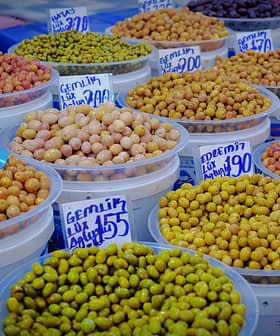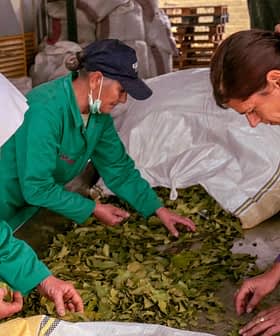Report Advises Greek Exporters to Innovate
After an analysis of the American olive oil market, the Greek Embassy in Washington says innovation is the key for Greek olive oil exporters.
Olive oil consumption in the United States has been steadily rising, with most of the oil being imported from Spain and Italy. Greek producers need to focus on quality, price, and innovative packaging to succeed in the competitive American market.
Consumption of olive oil in the United States has increased by 250 percent during the last 17 years and by 2.48 percent in 2017 compared to 2016, reaching a total of 326,000 tons.
Most of the olive oil consumed in the country is imported from Spain and Italy, while domestic production covers less than 5 percent of the demand.
See Also:The Best Greek Olive Oils
Embracing a healthier lifestyle, American olive oil consumption has shown a steady rise, making the country a key market for producers from around the globe.
This should not go unnoticed by Greek producers and exporters, who need to think out of the box if they want to succeed in the American market.
These and many more findings are contained in a report on the U.S. olive oil market, released last month by the Office of Economic and Commercial Affairs of the Greek Embassy in Washington, D.C. The report presented the current status of the market and identified trends and opportunities for existing and future exporters from Greece.
The U.S. olive oil market carries its own unique characteristics. The Department of Agriculture (USDA) has set standards for the different types of olive oil, but accreditation is not mandatory. This means that a shipment of olive oil can be imported and named extra virgin without checking whether it complies with the standards for the grade.
Also, there are no quality controls for olive oil imposed by the Food and Drug Administration (FDA) nationwide; instead, each state has established its own procedures and controls and only during recent years American producers have urged the regulating authorities to put some limitations and stricter controls on imported olive oil.
And while U.S. consumers increasingly replace butter and other oils with olive oil, it seems that they lack a complete appraisal for the product with one in three consumers stating that choosing which olive oil to buy is confusing. They usually buy their oil judging by two factors: price and the type of oil, with extra virgin being by far their top selection. Also, many consumers are willing to pay a premium for extra virgin olive oil of high quality from specialty stores.
Domestic producers in the U.S. have been gaining market share with one company, California Olive Ranch, accounting for around 65 percent of internal production. The 2017 production of olive oil has reached approximately 14,000 tons in California, largely due to the modern automatic processing methods.
Classification of olive oil in the country is based on its type (virgin or non-virgin), the size of the container (smaller or bigger than 18 kilos), and the country of origin.
Apart from extra virgin, virgin, and plain olive oil, organic olive oil is another option for U.S. consumers. There are strict directives regarding the term ‘organic,’ and the tag “USDA Certified Organic” on a product’s label indicates that the product complies with the regulations for organic food. These regulations apply to both domestic and imported organic olive oil.
The penetration of olive oil in American households has increased by 30 to 50 percent during the last five years and the annual consumption is about 1.1 liters per person. The East Coast is where most of the olive oil is consumed, due to the concentration of population and, historically, the traditions of immigrants from Italy.
The South-Atlantic region is second with 23 percent of total consumption, followed by Mid-Atlantic with 18 percent (data of 2016). The Pacific region, where domestic olive oil is made, ranks third with 12 percent of total consumption.
The report stressed that, due to the size of the country and its big population, even a slight rise in demand would have a huge impact on the total consumption of olive oil. On the other hand, an increase in demand also presupposes that consumers are well-informed about olive oil and its value.
The market is dominated by Spain and Italy, but olive oils from Greece, Portugal, Morocco, Tunisia, Turkey and South Africa are also present, among others. Apart from packaged olive oil products, imports of bulk olive oil have significantly increased in the U.S., to be processed by local bottlers and packaging facilities: in 2016, 42 percent of the imported olive oil was in bulk, compared to only 16 percent ten years ago.
When it comes to packaging, consumers prefer containers of 325 to 562 ML and tend to shy away from containers smaller than 300 ML and bigger than 3 liters.
Exports of olive oil from Greece to the USA have almost doubled in volume during the last five years from 5,500 tons in 2012 to 9,000 tons in 2016, with Spain and Italy being the leading exporters to the U.S. with about 139,000 and 132,000 tons respectively. In 2017, taking into consideration the data available (January to May), Greek exports slightly decreased by 2.2 percent compared to 2016.
In such a big and changing market, competition is naturally fierce, and Greek exporters have to strive should they want to expand their sales portfolio or win their first customers on the other side of the Atlantic.
More than 500 brands of olive oil are sold in the country with consumers showing little loyalty. However, Bertolli, Filippo Berio, and Pompeian were the market leaders in 2015 with 47 percent of total sales, and private label products occupied a significant portion of the market with 36 percent of total retail sales.
Private label products are usually cheaper than their branded competitors, and this is the main driver for the emergence of store brands. Market research conducted by the Office in November 2017 gave a price range of $9.05 — $11.51 for a liter of private label extra virgin, and a price range of $8.79 — $24.69 for a liter of extra virgin from well-known brands. Olive oil from Greece is usually on the cheaper side, with Spanish and Italian oils selling at higher prices.
The report noted that the two major disadvantages of the Greek olive oil industry are high production costs and lack of differentiation, with the latter leading to an over-reliance on exports in bulk. The motto of the rapidly growing global industry of consumer goods is “innovate or perish,” and the need for innovation is obvious in Greek olive oil products.
A field for innovation could be the packaging of olive oil: novel packages can overtake competitors by covering the need of American consumers for practicality and ease of use. For example, the caps of bottled olive oil sold by Crisco double as a measure to allow for an exact quantity to be consumed, while remaining oil can be channeled back to the container. Another case is Santini, which sells its olive oil including a discharge spout integrated within the bottle, making it popular among buyers.
Other ideas in the report included providing a small plate in the package to serve olive oil as a dip, or to accompany the container with a small box of related condiments. American consumers want food that comes in easy-to-use and ready-to-eat packaging that makes their everyday meals simpler and easier, the report found.
The report concluded that Greek olive oil exporters should focus on three parameters: quality, price, and packaging. Mastering these would provide them with the competitive advantage to penetrate the ever-expanding and promising olive oil market.









